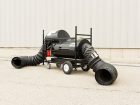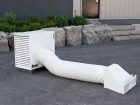
Heat smarts
By George Olah
Features Tech tipsMany of you in the rental business are readying your construction heater equipment for winter rental duty. There is much to do and know. More than ever before, rental companies and their customers are faced with a plethora of choices of construction heater models that offer a varying range of BTU-per-hour output. Luckily, we have some great and well-established made-in-Canada innovative brands.
 Today’s heaters come with a number of safety features that represent a vast improvement over older designs. This unit from Flagro produces 200 Many of you in the rental business are readying your construction heater equipment
Today’s heaters come with a number of safety features that represent a vast improvement over older designs. This unit from Flagro produces 200 Many of you in the rental business are readying your construction heater equipmentSome of the new energy-saving heating equipment can not only blow heat but also circulate air simultaneously. New heat ducting material is now available and it is more durable and sweeter-smelling than the old canvas ducts. Heaters are diesel-powered, others operate on electricity, and yet more are fuelled by propane or natural gas. Certainly, each fuel type has its benefit. I must admit I am partial to the operational portability and clean-combusting economic attributes of propane-fuelled construction heaters.
Whatever heater fuel model you choose, it must be approved for use in Canada. It is your responsibility to ensure the equipment you rent meets all safety compliance requirements of both federal and provincial regulatory authorities. If you are unsure if any of the equipment is non-compliant, ask your favourite professional equipment sales people to show you the compliance certification that came with the equipment. Equipment approvals can always be verified by calling the equipment manufacturer to confirm their product has certification for use in Canada. And that certification is not just for heaters but for hoses, couplings, ducting, propane fuel cylinders and electrical cords.
Don’t neglect to keep the manufacturer’s instruction book and parts list supplied with your equipment. They are UL-approved and come with the equipment for a reason: safety. Keep these documents with each model you rent. Equipment instruction documentation provides important, basic, how-to-operate instructions, including the manufacturer’s contact information in case anyone has questions about safely operating its product. Make it available to everyone renting your equipment so they understand that the radiant heater they rented is designed for providing temporary space heat and is not a pizza oven for reheating lunches. If you are missing these documents for older equipment, or equipment obtained at an auction, contact the manufacturer or visit its website and obtain the instruction manuals originally shipped with the product.
As someone who has worked on both the equipment manufacturer and rental company sides of the business, I cannot stress how important training is. First and foremost, training is a compliance requirement when using any rental equipment. And it is the responsibility of the rental company to ensure that whoever is renting its equipment knows how to use it. For example, in Ontario, training can be verified by ensuring the renter has an appropriate and acceptable Record of Training (ROT) certificate corresponding to the BTU-per-hour size of the propane-fuelled equipment they are renting. Remember to check the date on ROTs — they are valid for only three years. Those who rent equipment and are properly trained reduce the possibility of accidents, are less likely to ruin rental equipment and decrease the amount of nuisance calls, such as, “Where is the reset switch?”
Rental companies usually have certified trainers on staff providing these courses. If your company does not have such staff, you can always contact professional trainers recommended by your equipment suppliers. In the case of propane equipment, the Canadian Propane Association’s Propane Training Institute offers a national network of some 1,200 trainers who teach approved training courses satisfying the needs of the rental industry. I know – I am one of them.
Take note that many recent national code and regulatory changes have propelled updates to training requirements. Early this summer, Transport Canada issued new requirements for the transportation of dangerous goods. All hydrocarbon-based fuels are considered dangerous goods. So, if you are transporting diesel, propane or gasoline, it’s important you have the most up-to-date training. Knowing how to placard and document properly, as well as handle fuels safely, is critical to rental operations. Neither your insurance company nor safety inspectors appreciate non-compliant workers. I recently updated the PTI’s Transportation of Dangerous Goods Propane/LPG-specific course and there are new key changes to be aware of, so get trained to stay safe, compliant and avoid needless fines.
One of the disappointing things I often see on construction sites are heaters that are oversized or undersized for the job. This demonstrates that no one knew how to “size” a heater; they were just renting heaters in stock or came across a “good deal.” Proper training will help you make informed decisions on how to select the correct size and the type of heater for the jobsite and save costs.
Electric heaters are typically good for smaller jobs, when electricity is readily available, but most bigger job sites, including high-rise buildings or big box stores, have little electricity to spare. Selecting more practical solutions requiring oil-fired, natural gas or (my favourite) propane-fuelled heaters makes much more sense to rent. Heater portability gives increased site options and jobsite flexibility for the contractor.
Today, most modern indirect heaters with built-in venting and re-circulating air capability are rapidly becoming the heaters of rental choice. Venerable direct-fired heaters still offer a value per dollar spent per BTU-per-hour that is difficult to beat. Whatever type of heater you choose or recommend, ensure customers and workers alike know that you need fresh air to not only provide good heater performance but to also prevent a dangerous buildup of carbon monoxide (CO).
CO on a worksite is usually the result of incomplete combustion or lack of adequate air for safe heater operation. CO is a colourless, odourless gas that mixes readily with the air around us. In higher concentrations, CO can be deadly to workers. The simplest way of preventing unnecessary CO while providing heat is good ventilation.
When using direct-fired, hydrocarbon-fuelled heater equipment, ensure there is a minimum of one square inch of fresh air available for every 1,000 BTUs-per-hour output. For instance, a typical direct-fired 150,000 BTU-per-hour propane-fuelled construction heater would need a tarp or window opening of at least 150 square inches for fresh air ventilation. The placement of CO detectors on larger enclosed worksites for peace of mind is recommended.
Another simple way to reduce jobsite CO buildup is to properly service and tune heaters prior to rental. Well-trained heater mechanics in rental shops are a must. Completing the PTI 400-02 course can help ensure your heater mechanic’s training is up-to-date. Tuning up lawn mowers and maintaining construction heaters are two distinctly different streams of knowledge and training.
Also, know how to properly apply a Canadian Rental Association R2GO tag. Remember, you are certifying that you have checked that the equipment will work properly on the job site. Your customers are depending on you for equipment that works safely.
When heating party tents remember to inform your customers to allow for proper ventilation. Don’t confuse direct-fired tent heaters with indirect-fired tent heaters that safely exhaust products of combustion through their own vents. Both are often painted white and look very similar. If you are unsure, ask your rental supplier or read the heater’s equipment manual.
When supplying a construction heater, don’t neglect to determine whether electricity is required to power the heater. Most larger-capacity heaters need power for ignition circuits and burners. One of the major operating issues on site is consistent electricity supply. The other is the length and proper rating of extension cords. Whenever practical, recommend heaters with lower voltage requirements, as well as built-in digital voltage management so the heater doesn’t shut down unexpectedly.
Select heaters and fuel types providing the greatest worksite flexibility for the best value. The portability of propane- and oil-fuelled heaters gives you that choice. In my opinion at least, propane is a cleaner-combusting fuel and more environmentally friendly because even in the event of a propane fuel leak, the propane quickly dissipates without contaminating the ground like an oil leak. Good training will help reduce the potential for any type of fuel leak or spill.
Great rental service requires up-to-date training to be compliant. Rather than trolling equipment auction sites for old equipment bargains, invest in newer and more efficient made-in-Canada equipment to stay competitive, profitable and safe.
George A. Olah is advisor for business development and training programs with the Canadian Propane Association.
Print this page


Leave a Reply